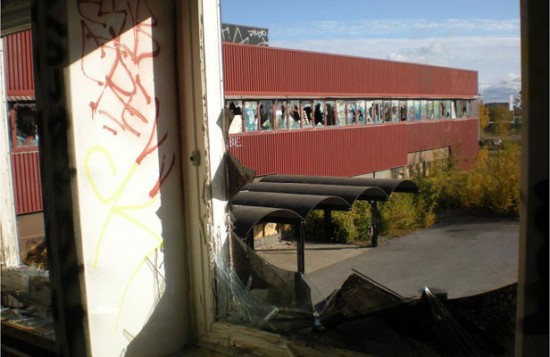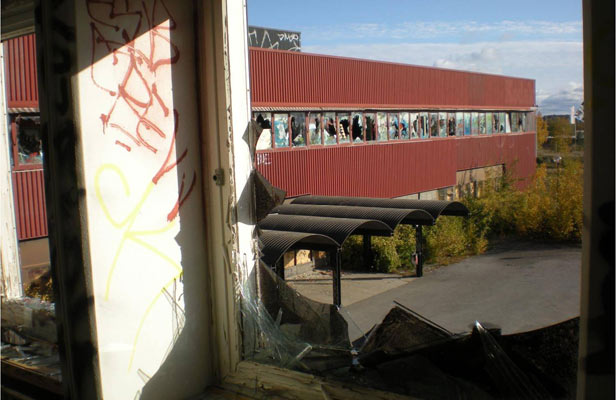Business Impact
You Press the Button. Kodak Used to Do the Rest.
Kodak saw the shift from analog to digital photography coming. Here’s why it couldn’t win.



When I photographed Eastman Kodak’s shuttered and vandalized film processing center outside of Stockholm a few years ago, it became clear to me that I held the very cause of all this destruction in my own hands: a digital camera.
Kodak held a monopoly position in the photographic-film industry throughout most of the 20th century. At its peak, the company employed more than 140,000 people, and its logo could be seen at every tourist attraction. In its hometown of Rochester, New York, the company was referred to as “The Great Yellow Father.” A job at Kodak was considered a job for life. In 1997, the stock market valued the company at over $30 billion.
Today Kodak is worth only $265 million. As rumors abound about a looming bankruptcy, the story we hear is that it failed to see the shift to digital photography, and management incompetence sped its decline. A closer look, however, reveals a different picture: Kodak not only recognized the coming shift to digital photography but was also in many ways a pioneer.
Source: PMA
How is it possible for a company to have seen a technological discontinuity yet still end up on the brink of bankruptcy? To understand what at first appears to be a paradox, think back to Kodak’s famous slogan “You press the button, we do the rest.”
Kodak always sold cameras, but its real business was “doing the rest” – supplying and processing film. During Kodak’s decades of dominance, the company built a vast and specialized infrastructure of machines, equipment, and skills in manufacturing, R&D, and distribution for film and photographic paper. With huge economies of scale and skills that were hard to replicate, barriers to entering the film business were very high. Competitor Fujifilm began to increase its global presence in the 1950s, but it took several more decades before the Japanese company became a serious threat to Kodak.
The large and complex process of operating a film business required a high degree of vertical integration. Kodak owned most parts of the supply chain; needless to say, control over basic research, raw materials, and film finishing further increased barriers to entry. The company had low production costs and few competitors, and back then people had no choice but to buy film in order to take photos. Kodak enjoyed tremendously high gross profit margins. Each “Kodak moment” was money in the bank.
Kodak also invested extensively in research and development. In fact, the first electronic camera using a charge-coupled device was invented by a Kodak engineer named Steven Sasson in 1975, and Kodak in many ways led early development in digital photography. The company introduced the first megapixel sensor in 1986, and the QuickTake camera launched by Apple in 1994 had to a large extent been developed by Kodak. It looked like a pair of binoculars, stored 32 photos, and could be connected to a personal computer.
But the limited performance and the high price tag of such cameras (the QuickTake cost about $800 and a high-end digital news camera ran $15,000) meant that the market for digital photography was very small, almost insignificant for a multibillion-dollar company like Kodak. It is often difficult for large firms to bother with small markets and small profits, but Kodak nevertheless made these efforts in the 1990s.
In the meantime, Kodak’s previously stable and solid film business became increasingly vulnerable. Fujifilm kept gaining market share, and in the mid-1990s a price war between Kodak and Fuji broke out in the United States. Eventually, Kodak had to lower prices. When George Fisher became CEO in 1993, he faced the challenge of fixing the core film business while at the same time preparing Kodak for the shift to digital photography.
Source: PMA
Fisher and most of his top management realized that digital imaging would displace film in the near future and that the company had to make dramatic efforts to transform itself. In a speech to the Academy of Management in Boston 1997, he said, “We are not in the photographic-film business or in the electronics business; we are in the picture business.” Seeking to ride out the technological shift, Kodak kept launching better and better digital cameras, pushed its way into digital printing, and began laying off thousands of workers.
But the industry landscape was completely different in the digital era. Barriers to entry were significantly lowered and the industry was flooded by entrants with a background in consumer electronics, such as Casio, Samsung, and Hewlett-Packard, not to mention Japanese camera manufacturers including Canon, Nikon, and Olympus. Large parts of Kodak’s competence base related to chemistry and film manufacturing were rendered obsolete. The vertical integration that had previously been a core asset to Kodak lost its value. Digital cameras became a commodity business with low margins. The problem facing Kodak wasn’t just that film profits had died but that those revenues could not be replaced.
Once images became digital, Kodak’s business model of “doing the rest” was effectively destroyed. Doing the rest used to entail a large and complex process that only a couple of companies in the world could master. Today, it is done by the click of a button.
Christian Sandström is a PhD researcher at the Ratio Institute in Stockholm and at the KTH Royal Institute of Technology.